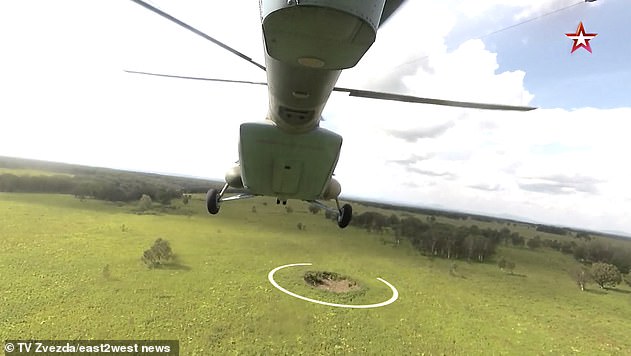
Russia is warning that new tests of its deadly hypersonic Satan-2 missile are imminent and on the brink of going into ‘serial production.’
Vladimir Putin‘s space chief Dmitry Rogozin has been seen inspecting the giant weapon as it was taken into a forest by rail.
‘The world’s most powerful global-range nuclear-tipped missile is being prepared for new tests and serial production,’ said Mr Rogozin.




The major new tests of Sarmat intercontinental ballistic missile mean it has already been suggested that it be deployed in Ukraine






Vladimir Putin’s space chief Dmitry Rogozin (left) inspects the giant weapon
Last month he said the doomsday weapon, also called Sarmat, was already in mass production.
Russia state TV and politicians have regularly suggested deploying the missile during the Ukraine crisis.
The Roscosmos chief recently visited the Krasmash defence plant in Krasnoyarsk, in eastern Siberia, to inspect the process of producing Sarmat for flight tests.






The Krasmash defence plant in Krasnoyarsk, eastern Siberia produces Sarmat for flight tests. Pictured: Kura training ground with missile craters






The Roscosmos chief recently visited the Krasmash defence plant in Krasnoyarsk, eastern Siberia, to inspect the process of producing Sarmat. Pictured: Head of Russian space agency Roscosmos Dmitry Rogozin






Mr Rogozin highlighted a 26ft deep crater made at the Kura test site by the missile without a nuclear warhead Pictured: Kura training ground with missile crater circled
The first and so far only test launch of a silo-based Satan-2 was on 20 April from the Plesetsk Cosmodrome in northern Russia.
Despite this, Russia is committed to commissioning the missile with the country’s strategic rocket forces by the end of the year.
In April, close Putin ally Mr Rogozin said there would be ‘a few more tests to prove the systems compliance with the technical parameters set by the chief client – the Defence Ministry’.
He has also said it would be commissioned no later than autumn which suggests there will be several upcoming tests.
Mr Rogozin has said the hypersonic 208-ton 15,880mph missile is ‘on schedule’.
The weapon is about the size of a 14-storey tower block and Mr Rogozin has said that Satan-2 is far ahead of anything the West has.
He said recently: ‘As for technical performance, what they have in their arsenal certainly lags behind what we have.
‘They lag especially far behind in terms of the designed capabilities of our Sarmat heavy intercontinental ballistic missile, which have been confirmed in the first test launch.’
The space chief also claimed that when he was at the production facility of the missile, which he called the ‘Doomsday Plant’, he was at the ‘safest place in the world’.
‘We are standing under the cover of the formidable Sarmat, created with great love and respect by our military factories and assembled at Krasmash to continue its flight design tests.
‘This is the safest place on Earth.’
Putin has said the missile would ensure Russia’s security and make ‘those fierce people who are trying to threaten it’ think twice.
There would be ‘no analogues to this weapon in the world for a long time to come’.
After the April launch, Mr Rogozin highlighted a 26ft deep crater made at the Kura test site by the missile without a nuclear warhead.
‘With a nuclear charge, such a crater at an enemy site will be…well, very large and very deep – and radioactive.
‘And not just one, but exactly as many as the most powerful nuclear missile in the world will deliver to the territory of a fierce enemy.
‘And we will soon have almost 50 such Sarmats (the missile is called Satan-2 in the West) on combat duty.
‘It remains only to advise the aggressors to talk more politely with Russia.’
Mr Rogozin himself has previously threatened to unleash Sarmat on the West.
He mocked an alleged report that Boris Johnson had threatened to deploy Britain’s nuclear missiles without consulting NATO.
Mr Rogozin threatened: ‘Boris, if ‘Sarmat’ is used, none of you will ‘consult with each other’.
‘And there will be no one to style your hair, Mr. Prime Minister.’